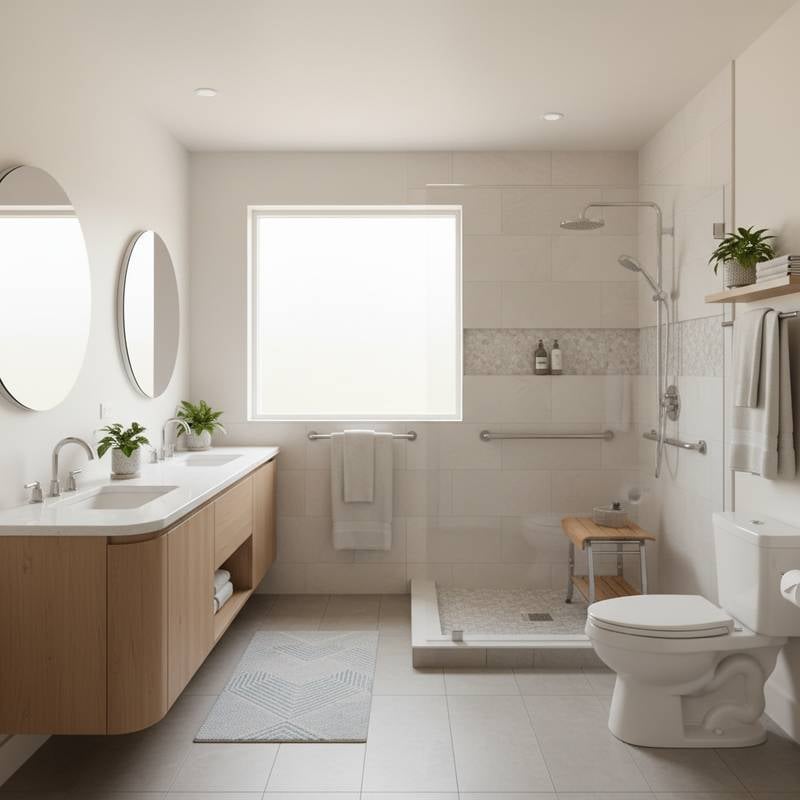Custom Home Costs: Smart Budget Strategies for Fall 2025
Quick Cost Summary
Building a custom home typically costs between $200 and $500 per square foot, with the national average at $300 per square foot. For a 2,500-square-foot home, the total investment ranges from $500,000 to $1.25 million, and most homeowners allocate close to $750,000.
The primary cost drivers include materials, labor, design complexity, land preparation, and permits. Materials encompass the quality of finishes such as flooring, cabinetry, windows, and roofing. Labor involves skilled tradespeople, construction crews, and specialized contractors. Design complexity covers architectural details, structural customizations, and layouts. Land and site preparation include clearing, grading, foundation work, and utility connections. Permits and fees account for local regulations, inspections, and impact charges.
Highlights and Key Insights
Building size and square footage represent the largest portion of overall costs. High-end finishes can increase the materials budget by two or three times. Site conditions, such as sloped terrain or poor soil quality, may add tens of thousands of dollars to the project.
Labor shortages affect bidding processes and elevate hourly rates. Engaging a design-build contractor often streamlines expenses more effectively than coordinating multiple vendors. Energy-efficient upgrades require higher initial investments but reduce long-term operational costs. Seasonal considerations influence pricing, as fall typically provides more flexible contractor schedules.
Contractor Costs and Professional Services
Labor constitutes 30 to 50 percent of the total build cost. For a $750,000 home, this equates to $225,000 to $375,000 directed toward professionals who handle design and construction.
Typical Construction Labor Breakdown
- General contractor fee: Ranges from 10 to 20 percent of the project total.
- Architect or designer: Accounts for 5 to 15 percent, based on the level of complexity.
- Skilled trades: Electricians, plumbers, HVAC specialists, and framers apply premium hourly rates that differ by region.
- Interior finishes: Cabinet makers, tile installers, painters, and flooring contractors contribute significant expenses, influenced by material selections.
Selecting experienced professionals minimizes errors and delays, which ultimately preserves the budget.
Ways to Save on Custom Home Costs
Effective planning enables control over expenses while upholding quality standards.
- Simplify the design: Opt for a straightforward floor plan with minimal complex angles to lower construction demands.
- Prioritize essential elements: Emphasize structural integrity and core features initially, deferring luxury finishes until funds permit.
- Standardize dimensions: Incorporate standard sizes for windows, doors, and cabinets to decrease material waste and labor time.
- Phase upgrades: Install preparatory wiring for smart technology or solar panels during construction, completing the systems at a later date.
- Select materials strategically: Builder-grade options deliver durability comparable to luxury brands at a fraction of the cost.
- Engage a design-build firm: A unified team overseeing design and construction eliminates redundant expenses and communication gaps.
DIY vs Hiring a Pro
When DIY is Realistic
Homeowners can manage landscaping, painting, and basic finish work to reduce labor costs. Tasks such as installing shelving, trim, or simple laminate flooring offer savings when executed properly. Sweat equity in non-structural elements cuts expenses without violating building codes.
When Hiring a Pro is Smarter
Structural framing, roofing, plumbing, and electrical systems necessitate licensed professionals. Permits frequently require certified work for mechanical installations. Errors in these domains lead to safety risks and expensive corrections.
Cost Differences
DIY efforts may save $5,000 to $20,000 over the course of the build. However, professional supervision averts mistakes that could exceed those savings. For substantial construction phases, professionals guarantee compliance and superior quality.
Cost Methodology
These figures derive from national averages compiled through contractor quotes, building surveys, and construction cost databases. Local market variations affect pricing, so homeowners benefit from obtaining at least three detailed bids from licensed area professionals.
FAQs
How much does it cost to build a custom home?
Most custom homes range from $200 to $500 per square foot, averaging near $300.
What is the biggest expense in building a custom home?
Labor and materials each comprise 30 to 40 percent of the total cost.
Is building a custom home cheaper than buying?
Purchasing an existing home generally involves lower upfront costs, yet custom builds allow customization of design, layout, and efficiency.
Can I build a custom home on a tight budget?
Affirmative, through restricting square footage, streamlining design, and selecting mid-range finishes.
How long does it take to build a custom home?
Projects typically span 10 to 18 months, contingent on complexity and site factors.
Do I need a general contractor?
Yes, absent extensive construction expertise. General contractors manage trades, timelines, and permits.
What upgrades offer the best resale value?
Energy-efficient systems, kitchens, bathrooms, and outdoor areas yield the highest returns.
Maintaining Your Investment
Upon completion of the custom home, focus shifts to preservation for sustained value. Routine upkeep averts major repairs and supports resale potential.
- Conduct annual inspections of roofing, siding, and gutters.
- Schedule HVAC servicing prior to peak heating or cooling periods.
- Apply fresh paint and sealants to safeguard surfaces and finishes.
- Implement strategic landscaping to control drainage and shield foundations.
Planning for ongoing maintenance prolongs material lifespan and upholds property worth.
Your Next Steps
To initiate a custom build, outline essential features and establish a realistic per-square-foot budget. Assess land options thoroughly, as site characteristics profoundly impact expenses. Solicit quotes from several contractors, evaluating not only pricing but also communication effectiveness and project oversight capabilities.
Consider future obligations beyond construction, including maintenance, utilities, and landscaping. A well-defined budget approach secures the home as a financial asset and enduring living space. Informed decisions throughout the process facilitate enjoyment of the property alongside fiscal discipline. With deliberate planning and judicious contractor choices, the custom home endeavor proves feasible and gratifying.









